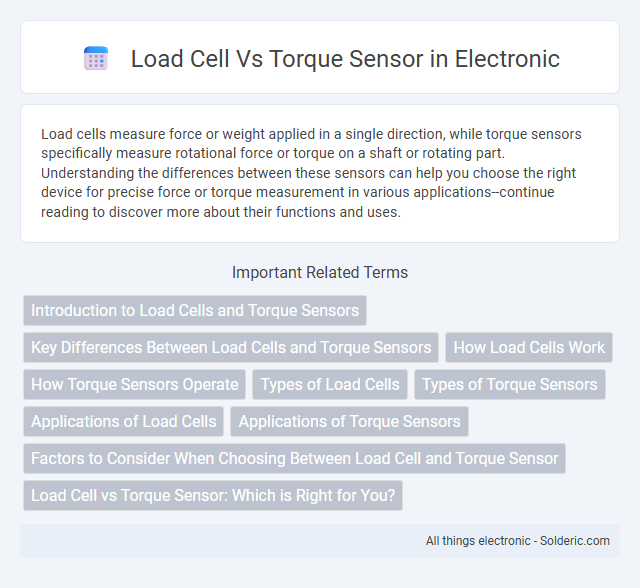Load cells measure force or weight applied in a single direction, while torque sensors specifically measure rotational force or torque on a shaft or rotating part. Understanding the differences between these sensors can help you choose the right device for precise force or torque measurement in various applications--continue reading to discover more about their functions and uses.
Comparison Table
| Feature | Load Cell | Torque Sensor |
|---|---|---|
| Primary Measurement | Force or Weight | Torque or Rotational Force |
| Common Applications | Weighing systems, force measurement, material testing | Motor testing, drivetrain analysis, torque monitoring |
| Measurement Principle | Strain gauge, piezoelectric, hydraulic | Strain gauge, magnetoelastic, optical |
| Output Type | Analog voltage, digital signal | Analog voltage, digital signal |
| Typical Units | Newtons (N), Kilograms (kg), Pounds (lbs) | Newton-meters (Nm), Pound-feet (lb-ft) |
| Sensitivity | High accuracy for linear force | High accuracy for rotational force |
| Installation | Mounted under load or between structure | Mounted on shafts or rotating parts |
| Typical Range | Millinewtons to kiloNewtons | Millinewton-meters to kiloNewton-meters |
| Cost | Generally lower than torque sensors | Generally higher due to complexity |
Introduction to Load Cells and Torque Sensors
Load cells measure force or weight by converting mechanical tension or compression into an electrical signal, essential in precise weighing systems and industrial applications. Torque sensors detect rotational force applied to a shaft, crucial for monitoring performance in automotive, manufacturing, and robotics industries. Understanding the differences between load cells and torque sensors helps you select the right sensor type for measuring linear force or rotational torque effectively.
Key Differences Between Load Cells and Torque Sensors
Load cells measure force or weight by converting mechanical force into an electrical signal, while torque sensors specifically measure rotational force or torque applied to an object. These devices differ in application, with load cells commonly used in weighing systems and torque sensors essential for monitoring engine performance and mechanical stress. Understanding these key differences helps you select the right sensor for precise force or torque measurement in your specific engineering or industrial project.
How Load Cells Work
Load cells measure force or weight by converting mechanical pressure into an electrical signal using strain gauge technology. When a load is applied, the strain gauges deform, causing a change in electrical resistance proportional to the force exerted. This precise measurement principle enables load cells to provide accurate and reliable data for various industrial and laboratory applications.
How Torque Sensors Operate
Torque sensors operate by measuring the rotational force applied to an object, typically using strain gauges attached to a shaft or rotating component that detect deformation caused by torque. These sensors convert mechanical strain into electrical signals, allowing precise monitoring of torque in real-time for applications like engine testing, robotics, and industrial machinery. Understanding how your torque sensor functions ensures accurate performance measurement and improved control in dynamic systems.
Types of Load Cells
Load cells come in various types including strain gauge, hydraulic, pneumatic, and capacitive load cells, each designed to measure force or weight with specific applications in mind. Strain gauge load cells are the most common, using electrical resistance changes to detect strain from applied loads, suitable for high-precision weighing systems. Hydraulic load cells operate by measuring fluid pressure changes under load, ideal for harsh environments, while capacitive load cells measure changes in capacitance caused by applied force, offering high sensitivity for dynamic measurements.
Types of Torque Sensors
Torque sensors include strain gauge, magnetoelastic, and optical types, each tailored for specific measurement needs. Strain gauge torque sensors measure deformation caused by applied torque, providing high accuracy in various industrial applications. Magnetoelastic sensors detect changes in magnetic properties under stress, while optical torque sensors use light modulation for precise and non-contact torque measurement.
Applications of Load Cells
Load cells are widely used in industrial weighing systems, material testing machines, and automated manufacturing lines to measure force, weight, and pressure with high accuracy. These sensors are essential in applications such as conveyor belt monitoring, packaging verification, and structural health monitoring, where precise load measurement ensures safety and efficiency. Your choice of a load cell can significantly enhance process control and quality assurance in diverse sectors like aerospace, automotive, and construction.
Applications of Torque Sensors
Torque sensors are essential in automotive testing, industrial machinery, and robotics to measure rotational force accurately. They help monitor engine performance, optimize manufacturing processes, and ensure precise control in robotic arms. Your ability to enhance equipment efficiency and reliability depends significantly on selecting the right torque sensor for these demanding applications.
Factors to Consider When Choosing Between Load Cell and Torque Sensor
When choosing between a load cell and a torque sensor, consider the specific measurement type required: load cells measure linear force or weight, while torque sensors measure rotational force or torque. Accuracy, environmental conditions, and installation constraints significantly impact sensor performance and suitability for your application. Your selection should align with the mechanical setup, required measurement precision, and the nature of the forces involved.
Load Cell vs Torque Sensor: Which is Right for You?
Load cells measure force or weight by converting mechanical force into an electrical signal, making them ideal for applications like weighing systems and material testing. Torque sensors specifically measure rotational force or torque, essential for monitoring engine performance, motor efficiency, and assembly processes. Choosing between a load cell and a torque sensor depends on whether your focus is on linear force measurement or rotational force monitoring.
load cell vs torque sensor Infographic

 solderic.com
solderic.com